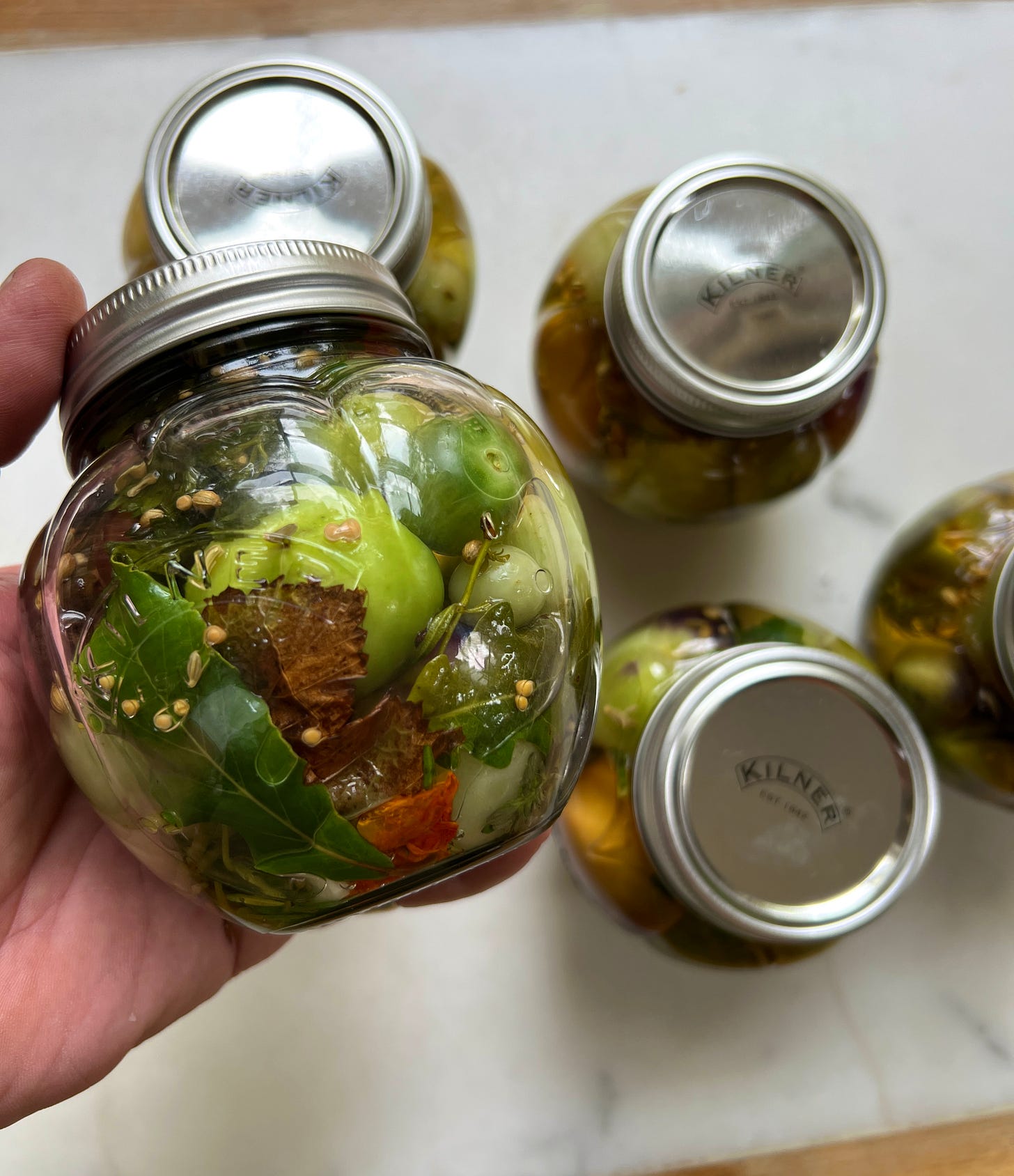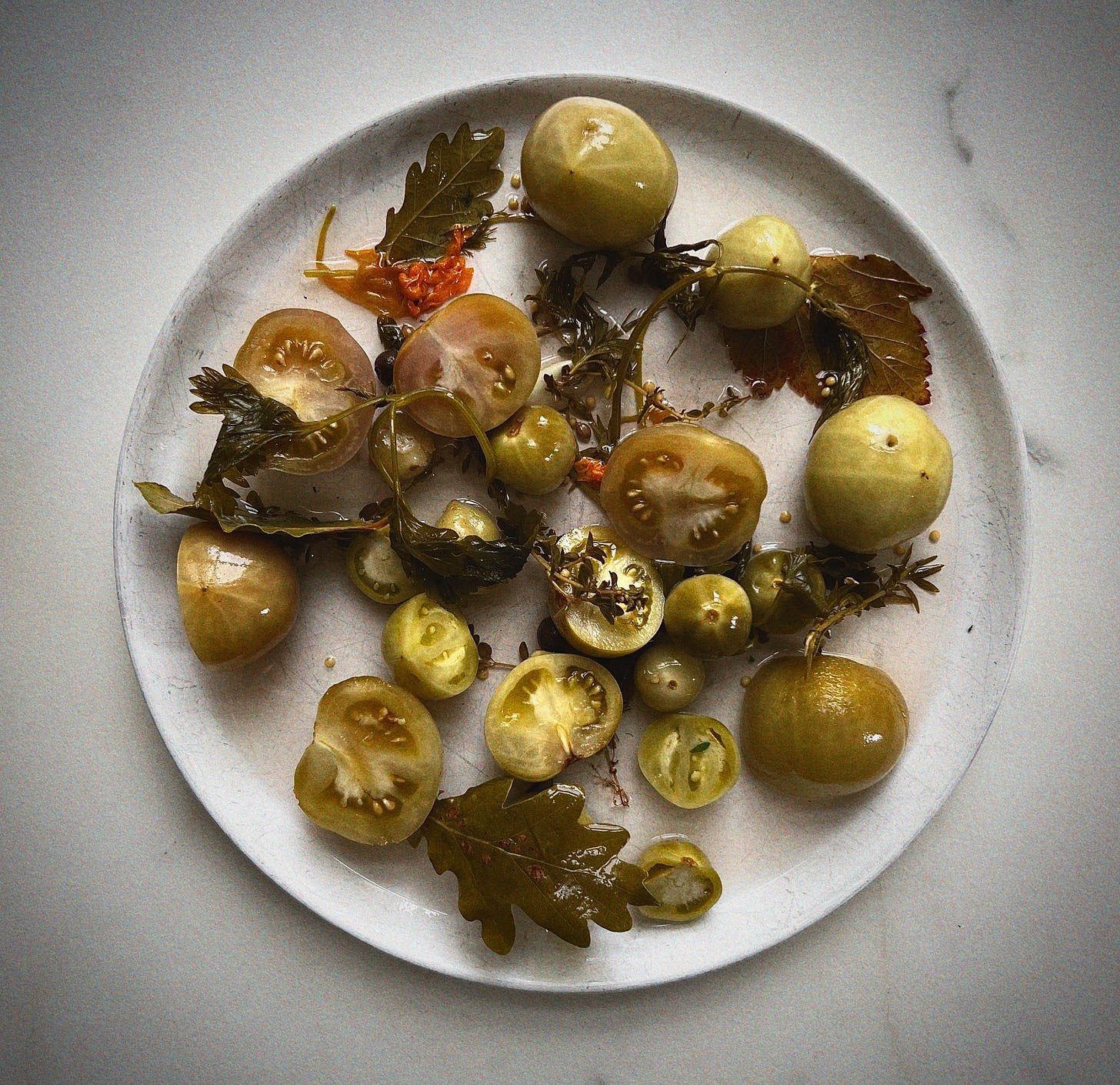Pickled green tomatoes with oak and blackcurrant leaves
Knitting needles, kitchen miscellany, and a goat with a penchant for bananas
This post is my weekly article for my paid subscribers.
For the price of a couple of croissants every month, you can have access to all of my writing and can trawl the expanding archive that stands at around eighty newsletters so far this year.
Well over one hundred thousand words.
I will always keep one weekly update free, but if you’d like to subscribe, then you’d be supporting the many hours I spend writing these words every week.
And for that I’m very ,very grateful.
A knitting needle isn’t usually a piece of equipment I’d keep in my knife roll, but it suits the task perfectly on this occasion. I’ve given it a slot to share with other important miscellany in the rows of soft leather compartments that hold the different sharp and useful things I use daily. It can share a space with a pair of fish pliers and a carved stick of hardwood that I once whittled and that looks like a wand, used for poking at things in the embers of fires, far too hot to be moved by hand. The pliers are snub-nosed, similar to a pair that an electrician might use; very good for pulling out the long curved bones from wild seabass, those piercingly sharp rib bones that have an annoying habit of puncturing you deeply in the side of the finger or better still, just under the side of your nail, sending everything red and swollen for a week and making sure that you can’t bend your finger. They usually do this on the day when say you might have a headache or something.
Just to make things that little bit more ruinous.
It fits there in its leather slot and seemingly as you never might know when you might need a knitting needle, I shall leave it there.
Unripe tomatoes
About one hundred unripe tomatoes of all shapes and sizes, green, black, purple and red, some with scars, some misshapen wait for me on the kitchen bench. The last ones to be picked from the plants grown under glass in the greenhouse this year, each one needing to be pierced through once, with the point of the knitting needle. It is perfect for the task today allowing the warm pickling juices, piquant with the flavours of allspice and mustard to seep into the fruits as they preserve over the coming months, sealed tightly in glass pots, stored upside down in the dark.
The greenhouse here, where the tomatoes spent the summer is a tall white framed, wooden beamed structure, pitch roofed with great, flat glass louvres that open by rack and pinion, to ventilate what can be stifling in summer, freezing in winter. It stands beneath tall oaks filled with acorns at this time of year, cypress trees, heavy with small cones, the feathery leaves bowing to the season. Bramble and yew are tamed as a backdrop against an old wall, lichen-covered, old stones leftover from where a tea garden once stood.
All those years ago.
A stone wall at waist height, where I sometimes go to stand and pluck mallards or wood-pigeon, their downy feathers, swirling in spiraling eddies in the sharp breeze that blows around my feet at this time of year. The wind will scatter these to the hedgerows, and in one rainy day they will be gone.
The greenhouse is where you’ll find all manner of interesting things grown by Jamie, a man who seems to be able to either grow or forage anything that I ask for. If I find seeds or discover a packet of something inspiring, then all I need to do is pass it over and he will sprout it.
Begun under warm glass and then transported to the raised beds to finish.
And if indeed it grows wild in a hedgerow or woodland, rest assured that he will be able to find it.
A real forager.
The kitchen garden has kept me well supplied this last year, with the beds being changed over once a season. No pesticides, just companion plants. Marigolds and nasturtium have kept the bugs mostly away, and have kept me topped up with an almost inexhaustible supply of leaves and petals.
Winter planting started in the warmth of summer, the celeriacs are fat now, and the small round carrots and candy-striped beetroot are ready. This summer we picked broad beans, peas, artichokes, cucumbers, onions, baby turnips, chard, spinach and borlotti beans. The beds are still filled with red chard, kale, celery, celeriac, aubergines, the very last of the corn cobs, and elongated turnips that I’m not sure as to whether the shape is deliberate or perhaps an anomaly.
The old greenhouse has a familiar feeling, warm, slightly damp and the soft warm smell of soil and the things that grow. There are large spiders who sit aloft, high above my head, the buzzing of a stuck wasp caught in the silk death that awaits it. Underfoot, small stones crunch and squeak as my foot twists in the deep gravel that lines the path to the door, I walk to the entrance, carefully observed by Petunia, a fine-looking rescued Anglo-Nubian goat, curious as to whether I’ve bought her a banana for her snack.
She can happily eat two or three including the peel and often the sticker.
A strange girl. Very beautiful though.
It is warm in here, humid and comfortable.
Peppers, tomatoes, aubergines, and as many little leaves as I could ever wish for grow under glass here at the top of the gardens. Mizuna, roquette, radish leaf, mustard frills, chard, bull’s blood, and chicory. The radicchio that is firming up in the beds was started here, blushed green to purple, lacking the bitterness that will develop in the winter months. I like to use it young like this as firstly I never came across it at this stage before growing it. Light in flavour, different to what it will become over the cold months outside. I like to wilt it briefly with a few ingredients to provide the heat it needs to soften very slightly as everything rests together in the residual heat of the pan.
Like the Iberico pork in the picture. Pickled tomatoes, globe artichokes, lemon zest, young radicchio and the blushed chunk of roasted shoulder meat.
The tomatoes that were left on the plants from the warmer months of summer, now refuse to ripen any further, so best to put them away for winter. Lacto fermentation is often my thing, but to the uninitiated, it can cause all sorts of problems and a good straightforward pickling brine is what is called for in this recipe.
Pickled green tomatoes
You will need to assemble some ingredients, some a little out of the ordinary.
Keep reading with a 7-day free trial
Subscribe to A Private Chef to keep reading this post and get 7 days of free access to the full post archives.








